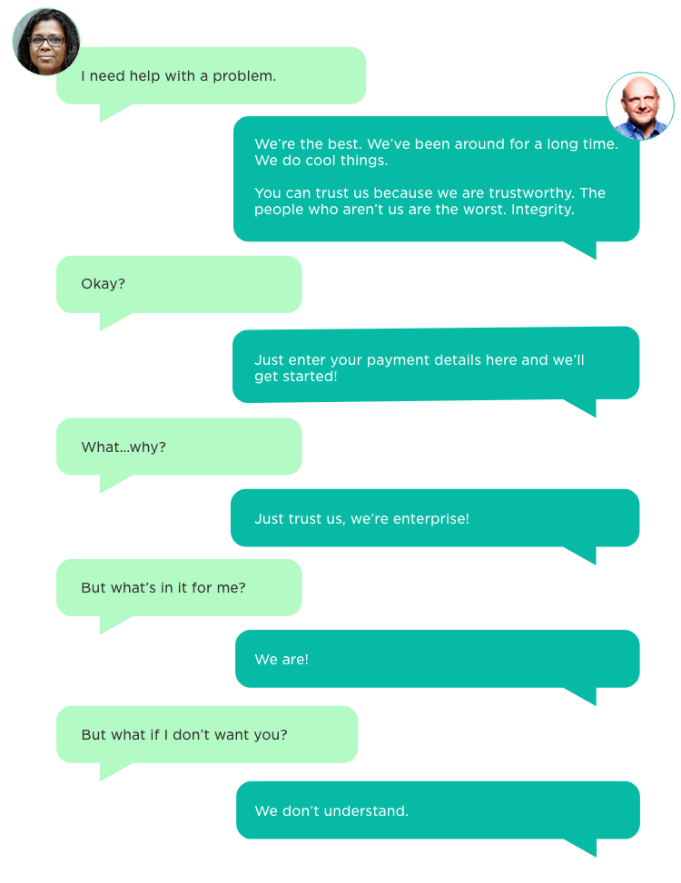If you want customers to invest in your brand, you must invest in them first.
Think about the last time you had a really amazing conversation with someone. Not just a conversation you enjoyed, but one that made you feel seen. One where you walked away feeling inspired, invigorated, and understood at a deeply personal level. You understood the other person’s values simply by how they made you feel.
Conversations like this make us feel good about ourselves, but they also make us think better of the person we were speaking with. We think they’re intelligent and interesting because they made us feel intelligent and interesting—and they did it simply by being an active, empathetic listener.
Now, you might also have noticed that some of your worst conversations were with people who wouldn’t stop talking about themselves—people so blinded by their own ego that they can’t see how their self-importance is boring the rest of us to tears.
We have all experienced both these conversations. One made us lose track of time, and the other made us excruciatingly aware of each passing second. One made us feel engaged and excited, the other made us feel trapped. One made us want to spend more time with the other person, and the other made us want to fake an illness and escape out of a side door.
There’s no mystery as to why we all prefer the first conversation partner. They are the kind of person we would rather have as a friend and business partner—and they are also the kind of person we would like to be ourselves.
And yet, somehow, when it comes to brand communication, so many companies sound like the second. Why?
Brand narcissism vs. brand altruism.
To answer that question, I’d like to introduce a paradigm. Let’s call the businesses who lead with self-absorbed language brand narcissists. If you’re having trouble picturing what their communication style looks like, let me offer an illustration.
Imagine a conversation that reads like this:

We can all recognize the self-absorption and lack of customer interest that is causing this brand to fail, and yet we’ve all also been on the receiving end of this kind of messaging. You may even be coming to the painful realization that you use it yourself.
The flip side of this paradigm—what brands should be striving for—is brand altruism.
Brand altruists recognize that the success of the brand depends on the strength of its customer relationships. And relationships mean showing up authentically. They even engage with a level or restraint and self-sacrifice, recognizing that it’s better to let some relationships go rather than expend a lot of energy on both sides trying to force a poor match.
Unfortunately, just knowing the difference between these two communication styles isn’t enough to keep some brands from falling into bad habits.
Signs and Dangers of Brand Narcissism
Even great brands slide into brand narcissism without realizing it. In fact, many marketers fall back into this style simply because it’s easy to sell to leadership. They know it’s what the owner of the company is expecting: for you to paint their brand in what they perceive as the best light. Meanwhile, the company owner truly believes every word—and it’s not setting off any narcissistic alarm bells because it’s all being said about their brand, not about themselves.
In other words, from where they’re sitting they see you shining a big beautiful spotlight on their brand. What they don’t realize is that it leaves the audience in the dark.
Brand narcissism often stems from brand anxiety. When a brand is desperate to attract new leads or grow their customer base, it can be especially easy to lean on grandiose language.
It can be more difficult to spot when the motivations are simply naïve. If you truly believe your company is the best solution, why is it narcissistic to say so? Isn’t that just confidence?
There’s nothing wrong with being confident (or even a bit cocky) about your brand. After all, confident people aren’t worse listeners than anyone else. They may even be better listeners, because they feel they have less to prove. The tell-tale sign of brand narcissism, however, is that their communication is overtly self-serving. Client needs are placed last, ignored or even (in the most toxic cases) ridiculed.
Signs of brand narcissism:
- They take customer buy-in for granted. They bombard customer inboxes with value-less corporate announcements and devote key messaging space to talking about themselves rather than helping customers.
- They focus on telling, not showing. They lean on statements such as “we’re the best” or “you can trust us” instead of demonstrating their quality and reliability through case studies or customer testimonials.
- They think they’re the right fit for everyone. They believe that the customer doesn’t know their own needs and devolve into arguing with the customer about what’s best for them rather than working collaboratively toward a solution.
- They focus on negativity. They engage in competition bashing instead of showcasing the qualities that make them excellent.
- They exhibit toxic positivity. They don’t acknowledge challenges, struggles, or difficulties. All their employees love working with them, every client is happy, and nothing has ever gone wrong.
- They try to fit everyone into the same box. They don’t consider what is relevant to their customer’s needs and instead push the same suite of services or the same products on every customer.
- They don’t take “no” for an answer. They won’t let you opt out of their marketing, they try to keep you from leaving their site, they use scare tactics to try to convince you to stay.
It should be obvious that none of these are successful long-term strategies. Brands that become overly narcissistic eventually lose touch with their customers. They view the world with blinders on and fail to adapt when the market changes around them. Unless they have a radical change of heart, they are destined to alienate their customers and eventually fail as a business.
Brand narcissism is toxic. Fortunately, brand altruism offers the antidote.
Brand Altruism: Placing Customers First
If brand narcissism happens when companies place the brand ahead of the customer, then companies can practice brand altruism by flipping that position on its head.
For example, many brands put a lot of work into defining their core values. The purpose of identifying core values is that it gives businesses a way to hold themselves accountable while setting expectations with employees about company culture. An owner of a company may believe that servant leadership is a core value, but if they don’t say that out loud, they may find several years down the road that they have fostered a company full of micromanagers.
Now, let’s say that company, having identified that servant leadership is a core value, and having successfully grown it as part of their culture, now wants to communicate this to their clients. Maybe they decide to put that as the headline of their home page, or they write an email to their client list talking about the importance this value has in their company.
They might be perfectly sincere, but in the process they’ve failed to practice servant leadership on behalf of their customer.
This is true of almost any core value you could name. Brand narcissists talk a big game. Brand altruists talk less and do more.
Signs of brand altruism:
- They recognize that customer buy-in must be earned. They respect their clients’ time and attention. They offer their best professional advice, but don’t presume to know better than the customer what is best for their business.
- They are eager to demonstrate value. They don’t expect customers to take their word for it, but are ready to supply case studies, testimonials, reviews, and other metrics to back up their claims.
- They care about their niche. They recognize that their services are not for everyone, and focus on attracting and catering to the needs of clients who are the best fit.
- They give credit where it is due. They are not threatened by competition who may be a better fit for clients outside their niche. They acknowledge cases where another option may serve a customer better.
- They communicate with grounded optimism. They do not set false expectations or make unrealistic promises. They embrace transparency and honesty and reject self-delusion.
- They adjust to accommodate the customer. They recognize that different customers have different needs and target their communication to be more relevant to their audience.
- They seek enthusiastic affirmation. They don’t chase after customers who aren’t interested. They seek to attract customer buy-in through education rather than wearing them down through dogged persistence.
Brand leaders build stronger customer relationships by placing their egos last.
Business books are full of leadership advice about the virtues of putting others first. It should be no shock to learn that brand leaders also succeed when they fixate less on their brand, and instead devote their energy into expressing their brand values through customer engagement.
Imagine a new conversation:
In short, brands need to give their customers a reason to care. And that reason needs to be based in the customer’s best interests. If that customer’s interests don’t align with yours, than the truth is that they’re probably not your customer—and that’s just fine.
No brand can be all things to all people. But, by investing in relationships with the customers who are a good fit, brands can build lasting connections that will benefit all parties. And that investment will pay off not just through long-term partnerships, but by attracting more clients who are an equally good fit.
But until those relationships are formed?
No one cares.
Nor should they.
No one owes your brand the time of day, let along the time it will take to read your email, until you demonstrate what’s in it for them.
Until they have a relationship with you—something around which to form associations—your brand is just an abstraction. All the thought and care, the attention to detail, the agonizing that went on behind the scenes over each and every nuance of your brand presentation—all that will matter one day, but not before you’ve demonstrated that you can live up to the image you’re setting.
No one is going to care about your brand until you care about them, first.
